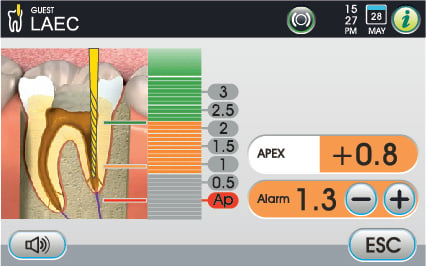In the dental care field, as in many other medical fields, dentists increasingly rely on technologies to support their work. These technologies, often centred around work instruments, result in the need for additional modules.
In the case of a dental practice, in addition to a chair, stools, the X-ray unit, a possible intraoral scanner and general furniture, adding an extra module for the micromotor or for the apex locator would clutter the space available for the medical staff even more.
The best solution, and not just from an ergonomic point, is the physical and functional integration of an electronic apex locator into the dental unit.
Evolution of the electronic apex locator
In endodontics, the viewing and measurement of root canals was carried out with traditional X-ray imaging until early in the last century. Then, over the decades, measurement based on electric current, first direct then alternating, became increasingly accurate, making it no longer necessary to expose the patient to multiple X-ray scans.
In recent years, we have achieved a level of measurement reliability and accuracy that has helped consolidate this technology. The result for today's endodontists is a highly valuable technological tool; however, having to use an electronic apex locator does not make it automatically convenient, especially if a stand-alone device is required.
Convenient integration of dental unit and apex locator
The stand-alone module, which is often added to another stand-alone module for the endodontic micromotor, is not the best solution from an operational point of view. Connection wires that overlap, modules that hinder dentist movements, having to control the chair, micromotor and locator via three different panels, all this does not help the efficiency of the procedure in progress.
The root canal instrumentation phase deserves a better workflow, which is feasible when all the instruments are integrated into the dental unit and managed by the same software.
How does the electronic apex locator work?
On the basis of the different degrees of conductivity of periapical and intracanal tissues, the electronic locator identifies the root canal apex. This step is the same for all electronic locators. In the version integrated in the dental unit, the Castellini Electronic Apex Locator (LAEC) transfers the obtained information directly to the instrument panel display. When a monitor is available on the operating light column, the medical team can view the procedure on a large screen.

In addition to ensuring convenient integration, which allows the dentist to focus on the procedure without having to manage an additional module, the advantage of this solution lies in immediate visual feedback with warning buzzers, allowing real-time monitoring of a delicate procedure.
On which dental units is LAEC available?
The integrated Castellini Electronic Apex Locator is available on the entire Skema range - Skema 5, Skema 6 and Skema 8 - on Puma Eli Ambidextrous and on the Surgical Cart.
Combined with the EVO E4 contra-angle, it integrates the APEX-STOP function which automatically switches the bur off upon reaching a set safety threshold.
Thanks to the full integration between locator, micromotor, dental chair electronics and the audiovisual instruments on the chair, the dentist can rely on a complete and extremely functional system for root canal treatment.


